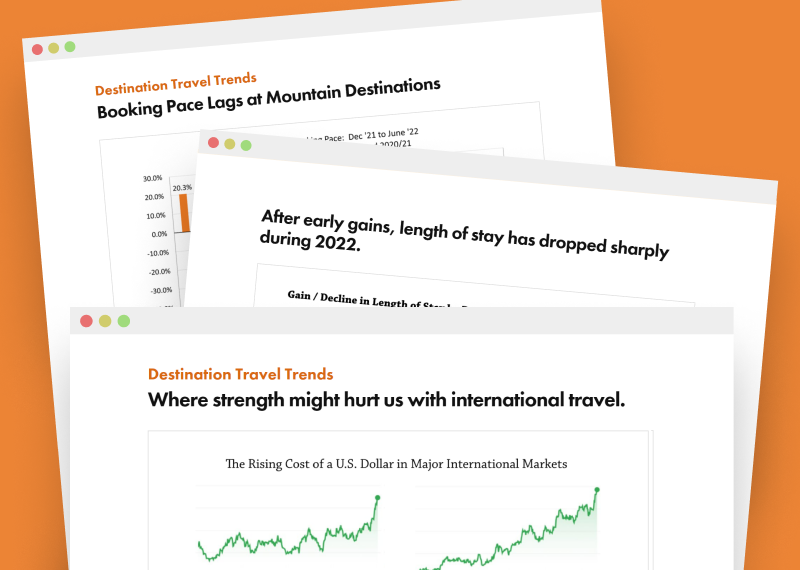 Tom Foley
Tom Foley
As talk around the country turns to reopening, recovery, and steps toward a return to normal, the same discussion is taking place around destination travel. As we ponder what that looks like, there are a lot of opportunities to explore the who, what, when, where, why, and how of it all. Below are questions prompted by a few ideas. Some are obvious, some less-so, but none are intended to provide answers; rather, they’re thoughts that you may (or may not) want to consider as you move towards the first steps of reopening.
The Reopening “Food Chain”
Reopening is being bandied about like it’s a thing – a tangible process. We all know – or suspect – that’s not the case. Rather than a light switch, or even a series of light switches, reopening is more likely to be a series of rheostats, one for each segment of the economy and applied first locally and based upon localized conditions. Some questions on this topic:
- Where in the order of reopening does destination travel fall? And, at what point does the destination travel rheostat start to get turned up?
- What comes first: the consumer or the staffing-up?
- Is there a time before which you should not be marketing?
- Do you time your reopening with your local conditions, your feeder market conditions, or a combination of both?
- If your feeder markets are still closed, should you be open?
If You Build It, Will They Come?
There’s a lot of product sitting idle out there. And there’s a lot of pent up demand waiting to use it. In a perfect world, that spells business. Health risks and closures aside, if everything “opened” tomorrow and there was no threat of Covid 19, is there a target consumer for your product?
- In a world where just shy of 22 million people are now registered as some version of unemployed or furloughed in the past four weeks alone – 10x the total number over the entire financial crisis of 2008/09 – what’s the expectation that they have or are willing to spend discretionary income?
Looking at that same question from a different angle. Closures and employment issues aside, if everything “opened” tomorrow and consumers were still in the same place they were six months ago, is there a target consumer for your product?
- With a lot of fear about health, what is the secret to creating enough consumer confidence in the safety of your product or destination in the immediate future to overcome those fears?
- Entire industries and branches of science have been built around and dedicated to helping folks cope with and overcome their fears and anxieties. How is that done in a marketing message?
Market Messaging – A Team Effort…Or Not
Any reopening probably shouldn’t occur in a vacuum. As municipalities need to coordinate with cities, and cities need to coordinate with other cities and counties, an even more grassroots consideration is how individual suppliers coordinate actions. But it’s a competitive marketplace.
- Who ‘green-lights’ the beginning of marketing efforts: the property / supplier, the DMO, or town or county government?
- Does it matter?
- Should a property or supplier start marketing without coordination from the DMO?
Rating a Product – Is a Hygiene Rating System in our Future?
For many weeks (or months) consumers around the globe have been trained to wash hands, avoid certain surfaces, wear masks, and be mindful of their surroundings. Many have converted to practicing – and being acutely aware of – a level of hygiene they’ve never incorporated into their routine before. These new habits may not break so easily.
- Is there a role for a regulatory agency, either federal, state, county, or industry-based, to play in a future “Hygiene Rating” to go alongside quality ratings? Such a rating system would have to measure cleaning products used, policies and procedures followed, staff training, and inspections in a standardized way.
- Can you actually Warrant or Guarantee hygiene? If so, should you?
- Would you create a sub-brand within your company related to cleaning crews, policies, etc.?
- How big a part of your marketing messaging should be around hygiene?
Liability…. It Had to Come Up Sooner or Later
We live in a broadly litigious society and there’s no shortage of finger pointing at the best of times. Some segments of the travel industry are already seeing early examples of lawsuits against suppliers by survivors and / or victims of Covid-19 infection alleging negligence on the part of the supplier.
- First and foremost: is there a real liability issue around Covid 19 and, if there is, what’s to stop that from spreading to other ailments such as the flu?
- What is the added operational overhead of dealing with limiting liability?
- Does the implementation of a Hygiene Rating system invite litigation?
- Does the discussion around hygiene and any hygiene ratings need to go beyond product suppliers and be considered at the town, county, or other level?
Capacity Issues
Whatever reopening ends up looking like, until there is an effective treatment and / or a vaccine, we should expect that capacity is going to be defined differently for the foreseeable future than it was in the recent past.
- If attempting to create a safe, uncrowded space for guests to stay, do you hold back inventory from the rental pool? The answer may be different for private home / vacation rentals than for hotels or condo / villa rentals that have shared spaces and common entrances.
- What then constitutes capacity?
Season Passes / Mass Pass Sales
Whether the product is theme parks, mountain ski resorts, or something as simple as air-boat sessions, season passes are intended to pre-fill. The model relies on (nearly) open-ended capacity at any given time that is then supplemented with individual ticket sales.
- At a time when capacity is changing, crowds need to be limited or eliminated, and lineups are extended, how does the season pass model change?
- With product capacity calculated based on infrastructure that is designed to compress attendees, not distance them, how does the definition of capacity change?
- What’s the revenue impact if the season pass model changes?
Measurement Issues
Operations will be changed over the next while, with practices such as holding back units making good sense.
- How will properties, suppliers, and researchers account for units that are not in inventory for rental but for which you have overhead?
- Will standard best practices need to be adjusted to ensure data accuracy?
- Will you report all units and adjust your occupancy goals?
- If so, what about RevPAR / RevPAU, particularly as you may have expenses related to held back units that are part of your revenue calculus?
Have a question? Just ask.

Tyler Maynard
SVP of Business Development
Ski / Golf / Destination Research
Schedule a Call with Tyler→

Doug Kellogg
Director of Business Development
Hospitality / Attractions
Schedule a Call with Doug→
If you're a current Inntopia customer, contact support directly for the quickest response →
Request Demo
A member of our team will get back to you ASAP to schedule a convenient time.



